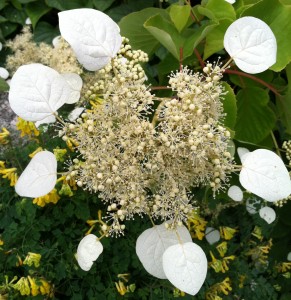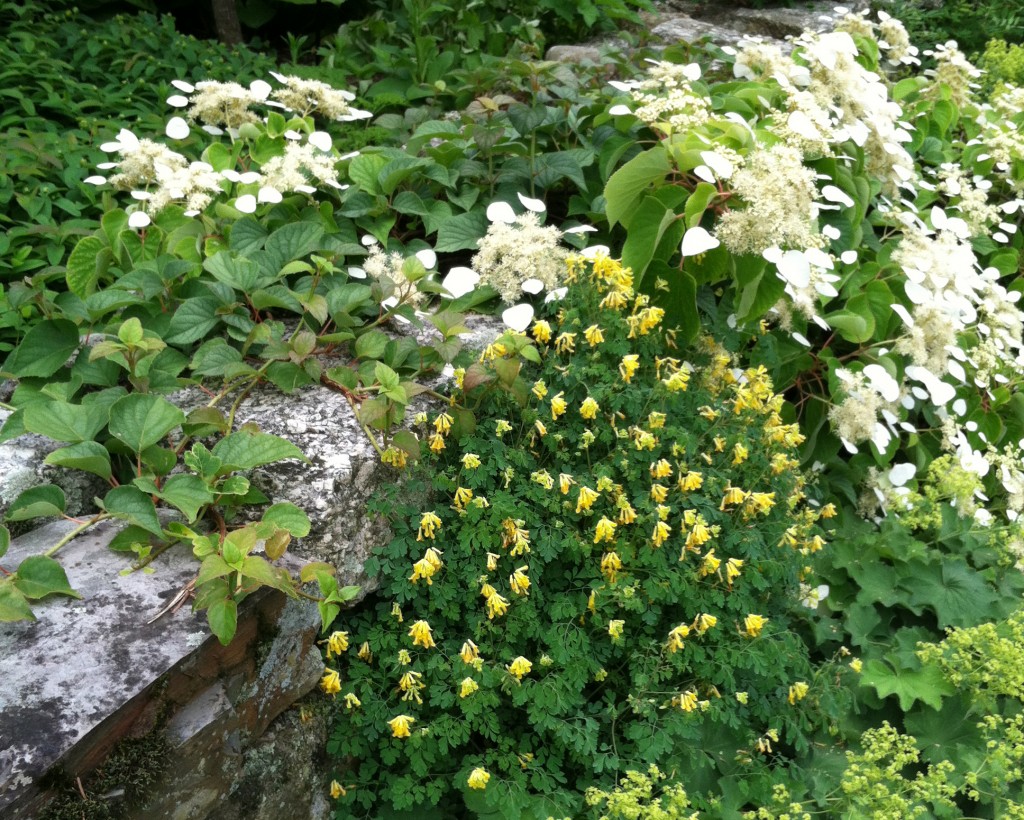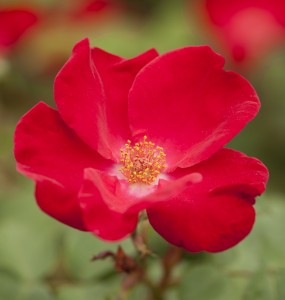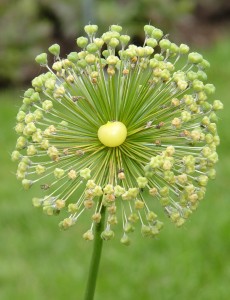Garden Moments
Posted in Gardening Tips, Gardens and Collections on July 2 2013, by Sonia Uyterhoeven
Sonia Uyterhoeven is the NYBG‘s Gardener for Public Education.

I often have visitors tell me that they love perennials, but their big challenge as gardeners is finding combinations that make it easy to synchronize bloom times. This is a real challenge particularly when the desire to create appealing plant partners meets a wish to provide multi-seasonal interest in the garden.
Annuals are an easy way to ensure season-long color, but they often lack the textures, stature, and architectural interest that perennials supply. In my walks around the Garden this year I have found two “garden moments” worth sharing—one serendipitous, the other planned. They are instructive examples in creating satisfying designs with limited plant palettes in your garden.
A few years ago, on a low stone wall in the Home Gardening Center, I planted a climbing hydrangea (Schizophragma hydrangeoides ‘Moonlight’). The climbing hydrangea is a woody vine that has blue-green, heart-shaped leaves and creamy white lace-cap flowers. It has stretched itself happily over the stone wall and filled in nicely.
Since the vine wants to crawl on the stone wall we needed to fill the space below, by its feet, and along the edge of the border. Lady’s mantle (Alchemilla mollis) seemed like a logical choice. This perennial only grows 12-18” tall and forms a nice clump, with large, scalloped, light-green to blue-green foliage. Furthermore, lady’s mantle flowers alongside the climbing hydrangea in June, producing clusters of showy chartreuse flowers.
While this duo was planned, we also had yellow corydalis (Corydalis lutea) in the same garden. This plant has a tendency to hop around, and here it inserted itself into a nook in the stone wall growing adjacent to the climbing hydrangea and lady’s mantle. Corydalis has diminutive yellow flowers and bluish, fern-like foliage.

These three plants partner beautifully with each other. The size and the shape of the foliage varies dramatically, providing nice texture to the design. Various shades of blues and greens are highlighted in the leaves, as well, making the foliage an integral part of the color palette. The light and airy chartreuse flowers of the lady’s mantle and the cheerful yellow flowers of the corydalis pair beautifully and stand up to the large white lace-cap flowers of the hydrangea. Nearby, the foliage of Hosta ‘June’—with its chartreuse to golden centers and its blue-green margins—echoes the color combination.
As the season progresses, the corydalis will continue to bloom, the lady’s mantle foliage will continue to look lovely, and the climbing hydrangea will continue to flower for a bit longer. It is a good reminder in terms of design that foliage can play an integral part in the color scheme.
The other “garden moment” was in the Peggy Rockefeller Rose Garden. At the entrance to the garden we planted two shrub roses: Rosa ‘Chipotle Vigorosa™’ and Rosa ‘Home Run®’. Both of these roses are compact—‘Chipotle Vigorosa™’ reaches 2-3 feet tall and ‘Home Run®’ reaches 3-4 feet tall with a nice round habit. One rose is a single bloom, the other double, and they play off of each other with their varied shades of red.

In amongst the roses, our Senior Rose Advisor, Peter Kukielski, planted an ornamental onion named Star of Persia (Allium christophii). This allium has an enormous, globe-like inflorescence which is covered with small, star-shaped lavender flowers. Once the flowers fade, the seed head keeps its ornate structure and continues to look beautiful in the garden.
This is a match made in heaven. Ornamental onions have beautiful flowers and seeds heads, but their foliage starts to fade and look scrappy just when the flowers begin to open. The mounding roses hide their ugly feet when they are in flower. Roses like good air circulation and the allium have a strong, slender stalk and an upright habit so no one gets crowded in this design.
There is also a nice twist to this combination. In terms of companion planting lore, good garden companions enhance one another’s growth and in some way protect each other from harm. Companion plants may help discourage pests without the use of chemicals since there are natural substances in their leaves, flowers, or roots that repel insects. Roses and onions are supposedly one such instance. Members of the onion family, which include ornamental alliums, are rumored to increase the perfume of roses, ward off aphids, and prevent black spot.

This however, is just an aside for this design. ‘Home Run®’ comes from the lineage of Knock Out Roses®, which are disease resistant, and ‘Chipotle Vigorosa™’ is a disease resistant Kordes hybrid. Their genetics will go further to keep the black spot away than a neighboring ornamental onion. Neither roses are fragrant, but they are the right height and a great color combination.
So what is the lesson in this design? The roses and alliums inhabit the space nicely in terms of height and space requirement. The alliums also add an accent to the design—something unusual to peak your interest. Sometimes little extra touches are all we need to make a good design into something exceptional. There are many “garden moments” to be found at the NYBG, so come visit, explore, and glean ideas for your own garden.

